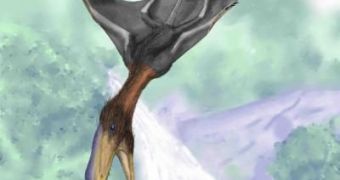Researchers in China and the United Kingdom have identified the first convincing set of pieces of evidence hinting at an unusual and controversial type of evolution, when they have discovered the remains of a peculiar flying lizard. The animal seems to have been in the habit of hunting other flying creatures during its days, the international collaboration reports. Scientists from the University of Leicester, in the UK, and the Geological Institute, in Beijing, China, contributed to the study, ScienceDaily reports.
The new flying reptile, which has been aptly named Darwinopterus, fills a gap between the two known kinds of pterosaurs – the long-tailed ones that came first, and the later, more “advanced” versions that grew to impressive sizes and had shorter Tails. These animals lived in the Mesozoic Era, between 225 and 65 million years ago, also known as the Age of Dinosaurs. However, they are divided by an evolutionary gap, which paleontologists believed would remain opened for a long time to come.
Such gaps are common, because very few animals turn into fossils, and even fewer of them are ever found by diggers. A site in northeastern China has, however, revealed some 20 skeletons belonging to the new Darwinopterus, which was named thus in order to celebrate Darwin's 200th birthday, and the 150th anniversary since On the Origin of Species was first published. The rocks in which the remains were uncovered were dated to be about 160 million years old, the experts report in the latest issue of the journal Proceedings of the Royal Society B: Biological Sciences, adding that some of the fossils were very well preserved.
The new flying lizards were thus proven to pre-date the first bird, Archaeopteryx, by at least ten million years. The analysis of the remains proved that the animal was the size of a crow, and most likely acted similar to a hawk, feeding off other flying reptiles, or on gliding creatures that were just learning how to fly.
“Darwinopterus came as quite a shock to us. We had always expected a gap-filler with typically intermediate features such as a moderately elongate tail – neither long nor short – but the strange thing about Darwinopterus is that it has a head and neck just like that of advanced pterosaurs, while the rest of the skeleton, including a very long tail, is identical to that of primitive forms,” UL School of Museum Studies research team member David Unwin shares.
The new research hints at “modular evolution.” This means that segments of the bodies evolve differently, until the entire aspect of a creature finally changes. The idea is highly controversial among scientists, and very little proof to sustain it has been available until now. Such a type of evolution would account for the massive evolutionary radiation of mammals just after the K-T event ended the age of the dinosaurs, some 65 million years ago.
“Frustratingly, these events, which are responsible for much of the variety of life that we see all around us, are only rarely recorded by fossils. Darwin was acutely aware of this, as he noted in the Origin of species, and hoped that one day fossils would help to fill these gaps. Darwinopterus is a small but important step in that direction,” Unwin concludes.

 14 DAY TRIAL //
14 DAY TRIAL //